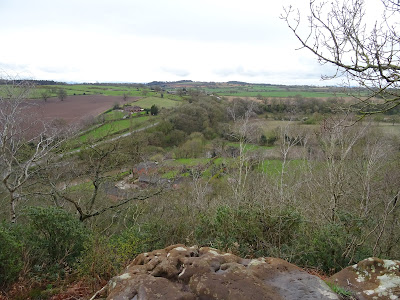Wednesday 27th March 2024, Lee Hills
Lee Hills are a pair of hills overlooking the village of Lee Brockhurst. The slopes and the summits are cloaked in woodland and there is a large area of grassland between the two peaks.
It was raining as we gathered at the edge of the village in the shadow of the hills.
Actually, there were no shadows, The sun was hidden by thick cloud.
And even if the sun was shining there would be no shadows over the village as the hills were to the north!
The problem with hills is that you have to climb them to get to the top.
The rain stopped as we walked along the road to a public footpath sign pointing into the hillside. Having scrambled over the style we were met by a path that ascended steeply.
Unfortunately, this initially distinct path soon became indistinct.
We managed to pick our way through the trees and Rhododendron to find a clearer area that allowed us to see where we were making for.
We paused for a breather.
Continuing up we finally made the path that circumnavigates the hills.
Once on the path we wandered to the left, doing quick searches of the vegetation as we went, arriving, quite soon, at a viewpoint.
The sandstone rock that provided the viewpoint was obviously a big attraction for the local artists who made their marks on the stone.
Turning around from the viewpoint we could see the summit of the southern hill.
Up we went.
A shorter and gentler slope.
At the summit we found the ruin of a small stone building. This became our base for a while.
Sending out search parties from here we managed to find quite a few species of interest.
A lichen, Cladonia polydactyla.
 |
| Photograph: John Martin |
The fungus Sphaerulina azalea, which is found on Rhododendron.
All three forms of 10-spot ladybirds:
decempunctata;
 |
| Photograph: Nigel Cane-Honeysett |
decempustulatus;
 |
| Photograph: Nigel Cane-Honeysett |
and bimaculata.
 |
| Photograph: Nigel Cane-Honeysett |
A red velvet mite, sorry I do not know the species.
 |
| Photograph: Nigel Cane-Honeysett |
A fly, Opetia nigra.
 |
| Photograph: Nigel Jones |
An “inconspicuous” ladybird, Nephus quadrimaculatus, known as the Ivy ladybird.
 |
| Photograph: David Williams |
Lunch was enjoyed.
Before moving on after lunch another foray into the undergrowth discovered three more species, one of which we were unable to identify.
A ground beetle;
 |
| Photograph: John Martin |
A pill woodlouse, Armadillidium pulchellus;
 |
| Photograph: David Williams |
And a harvestman that has been given the rather mouthful of a name, Sabacon viscayanus ramblaianus.
 |
| Photograph: John Martin |
Moving north from the southern summit we moved down onto a large grassland that covers the saddle between the two hills.
By now the clouds had broken up allowing the sun to emerge. This encouraged a couple of bees to venture forth and pose for photographs.
A Tawny mining bee.
 |
| Photograph: David Williams |
A Red-tailed bumble bee.
 |
| Photograph: David Williams |
Also spotted, was an Ichneumon wasp. I am reliably informed that it is a member of the Ophion genus.
 |
| David Williams |
However, the sun did not encourage these 7-spot ladybirds to emerge from the safety of an old fruit of a Sweet chestnut.
We eventually reached to far side of the grassland as it rose to give way to more woodland on the northern hill.
There was a choice at a branch in the path. Follow it as it climbed over the other side leading to a path down and back to the cars, or, continue straight on until it met a lane that would provide a longer but gentler descent to the cars.
We headed for the lane ...
Passing a dead branch on which there was an eruption of Witches’ butter.
 |
| Photograph: Nigel Cane-Honeysett |
As we walked down the lane we passed some patches of Cuckoo pint which were infected by the parasitic fungus, Spermosporia aricola.
 |
| Photograph: Nigel Jones |
The rain restarted just as we got back to the cars.
My thanks to the National Trust for allowing us to do what we enjoy doing. My gratitude to the photographers for sending me their images to illuminate the report.
%202024-03-27.JPG)































No comments:
Post a Comment
Please feel free to comment on this post...